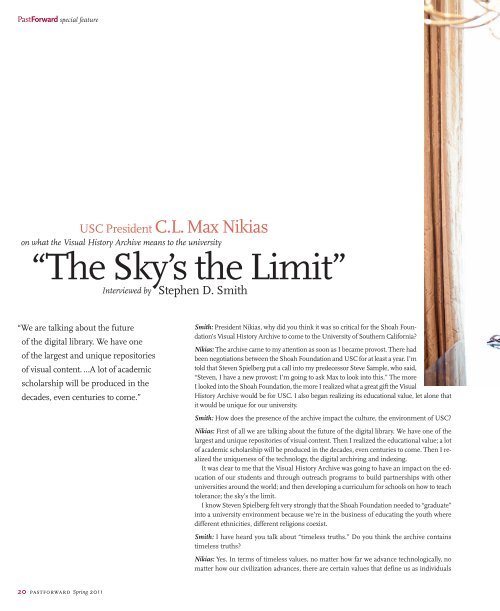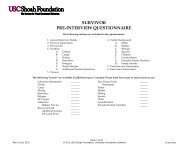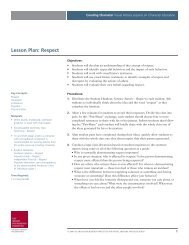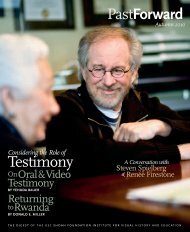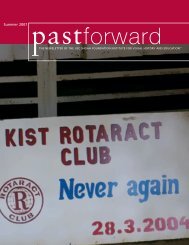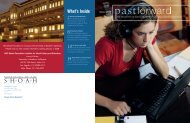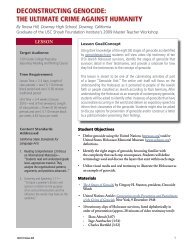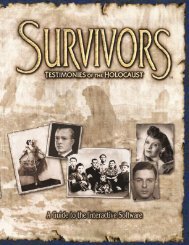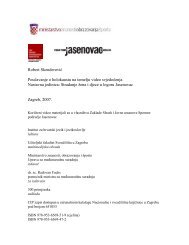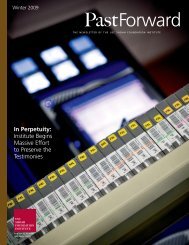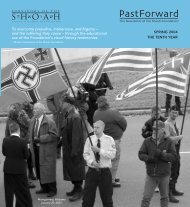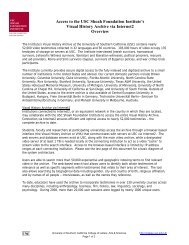Insights - USC Shoah Foundation - University of Southern California
Insights - USC Shoah Foundation - University of Southern California
Insights - USC Shoah Foundation - University of Southern California
Create successful ePaper yourself
Turn your PDF publications into a flip-book with our unique Google optimized e-Paper software.
PastForward special feature<br />
<strong>USC</strong> President C.L.Max Nikias<br />
on what the Visual History Archive means to the university<br />
“The Sky’s the Limit”<br />
Interviewed by Stephen D. Smith<br />
“We are talking about the future<br />
<strong>of</strong> the digital library. We have one<br />
<strong>of</strong> the largest and unique repositories<br />
<strong>of</strong> visual content. …A lot <strong>of</strong> academic<br />
scholarship will be produced in the<br />
decades, even centuries to come.”<br />
Smith: President Nikias, why did you think it was so critical for the <strong>Shoah</strong> <strong>Foundation</strong>’s<br />
Visual History Archive to come to the <strong>University</strong> <strong>of</strong> <strong>Southern</strong> <strong>California</strong>?<br />
Nikias: The archive came to my attention as soon as I became provost. There had<br />
been negotiations between the <strong>Shoah</strong> <strong>Foundation</strong> and <strong>USC</strong> for at least a year. I’m<br />
told that Steven Spielberg put a call into my predecessor Steve Sample, who said,<br />
“Steven, I have a new provost; I’m going to ask Max to look into this.” The more<br />
I looked into the <strong>Shoah</strong> <strong>Foundation</strong>, the more I realized what a great gift the Visual<br />
History Archive would be for <strong>USC</strong>. I also began realizing its educational value, let alone that<br />
it would be unique for our university.<br />
Smith: How does the presence <strong>of</strong> the archive impact the culture, the environment <strong>of</strong> <strong>USC</strong>?<br />
Nikias: First <strong>of</strong> all we are talking about the future <strong>of</strong> the digital library. We have one <strong>of</strong> the<br />
largest and unique repositories <strong>of</strong> visual content. Then I realized the educational value; a lot<br />
<strong>of</strong> academic scholarship will be produced in the decades, even centuries to come. Then I realized<br />
the uniqueness <strong>of</strong> the technology, the digital archiving and indexing.<br />
It was clear to me that the Visual History Archive was going to have an impact on the education<br />
<strong>of</strong> our students and through outreach programs to build partnerships with other<br />
universities around the world; and then developing a curriculum for schools on how to teach<br />
tolerance; the sky’s the limit.<br />
I know Steven Spielberg felt very strongly that the <strong>Shoah</strong> <strong>Foundation</strong> needed to “graduate”<br />
into a university environment because we’re in the business <strong>of</strong> educating the youth where<br />
different ethnicities, different religions coexist.<br />
Smith: I have heard you talk about “timeless truths.” Do you think the archive contains<br />
timeless truths?<br />
Nikias: Yes. In terms <strong>of</strong> timeless values, no matter how far we advance technologically, no<br />
matter how our civilization advances, there are certain values that define us as individuals<br />
20 pastforward Spring 2011


